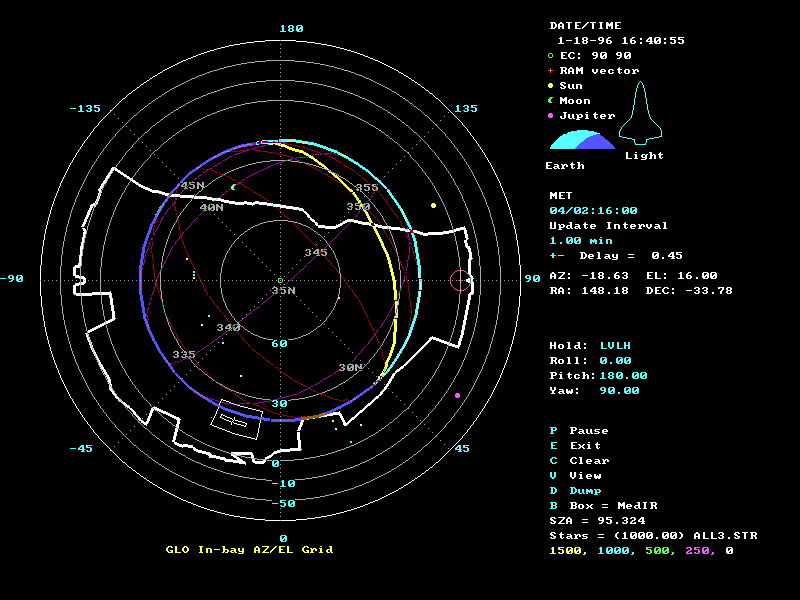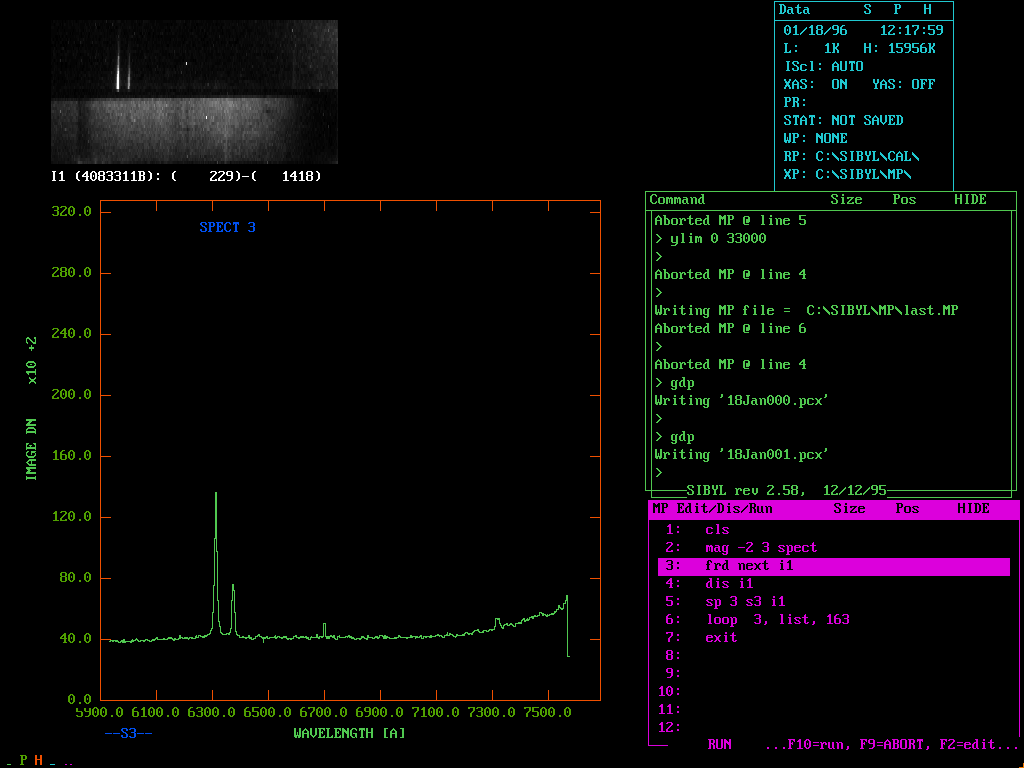-
 Software
Software
 GLOView Software
GLOView Software
 Sibyl Software
Sibyl Software
GLO Utility Software
The software is DOS based, and the following text describes how
we run the programs on our machines.
There are the three main utility programs designed for GLO data handling:
- GLOView - Gives a diagram of the view out of the shuttle bay
- from the position of our instrument. It is used for planning
- experiments and to review where the instrument was looking at
- any particular time.
- SIBYL - A GLO image handling program which provides access to
- the spectral and imaging data.
- SPECT - An analysis program for doing the same operations on all
- spectra in a set at the same time. It is used mostly for calibration.
- This program is not available at this time.
On our computers, each utility program resides in its own directory,
with supporting sub-directories. In addition, miscellaneous programs
and batch files are in the sub-directory \util\glo, which is the
only directory that needs to be added to the read path to run
our software.
Our directory set-up has the following structure:
C:\
|- GLOVIEW
|- SIBYL --------;- CAL
| `- MP
|- UTIL ----------- GLO
The CAL sub-directory contains many ascii files which give
calibration information, etc. about the instrument and flight.
The MP sub-directory contains mimi-programs to preform lists of Sibyl
commands.
Note: It is difficult to predict all the problems new users may
- have using the data or software. Please see our frequently
- asked questions (FAQ) page for answers to the most common
- questions. If you have suggestions for our documentation or
- other questions, please let us know.
GLOView is a graphical software package used for planning
observations before and during Shuttle flights and for
reviewing where the instrument was looking on previous
missions.

This is a screen display for a time during STS-63.
Click on the image to see an enlarged view of the screen with some of the
features labelled.
The center of the display is the Shuttle -Z axis (out of
the bay). The entire spatial sphere is represented, with
the +Z (beneath the Shuttle) hemisphere at lower resolution.
GLOView uese data files to input the Shuttle orbit, attitude,
GLO az/el, the Shuttle mask, a UV star catalog, and the user's
default configuration.
-
-
 Software for STS-63
Software for STS-63
 A self-extracting archive of the GLOView program for STS-63
called gv-sts63.exe is available.
A self-extracting archive of the GLOView program for STS-63
called gv-sts63.exe is available.
 Software for STS-69
Software for STS-69

 A self-extracting archive file for GLOView program for STS-69
called gv-sts69.exe is available for downloading.
A self-extracting archive file for GLOView program for STS-69
called gv-sts69.exe is available for downloading.
Sibyl is a command-driven program developed to handle the data returned
from CCD spectrographs and imagers; in particular, data in FITS format from
the Arizona Airglow Instrument (GLO). The experiment is flown under the
GLO acronym and will continue in a series GLO, GLO2, etc. Sibyl is
usually resident in its own directory and has subdirectories CAL and
MP. The CAL directory carries all of the calibration data required to
handle the data set. This includes bad pixel files (.HPX), sensitivity
files (.ASC), slit straightening files (.SLT), wavelength calibration files
(.WVL), regions selection files (.REG), dark frames (.FIT), etc. The MP
directory carries the mini-program files which are called, edited and run
in Sibyl.
Auxiliary programs are carried in a UTIL/GLO subdirectory which also
contains the batch files for various functions. The batch file S.BAT is
used in our system to call SIBYL. Internal to the file, a screen capture
utility program can be called and configured to allow screen dumps from
within Sibyl. We use the screen capture program GRAFPLUS.
SIBYL log files are saved in the directory that SIBYL was started from.
The log file has the name 'SdyMON##.LOG". (S for SIBYL, dy=day#,
MON=month, ## = incrementing number sequence. An example of the third
SIBYL log file created on Jan. 18 would be S18JAN02.LOG.)
SIBYL gives the most flexibility in handling single spectra. It is
most convenient to call it from within the directory you wish to work.
Preset paths are contained in the SIBYL.CFG file for various functions.

This is a screen display of a spectral image from STS-69. Below the image
is a plot of one of the two spectra shown on the image.
Click on the image to see an enlarged view of the screen with some of the
features labelled.
Getting Started: A Sample Session
Go to the SIBYL directory and print out the help file SIBYL.HLP.
Notice the HOT keys at the top of the file, then the command summary list,
followed by the command detail. The command detail can be accessed within
the SIBYL program by the HELP command. Move to and examine the files in
the directory \SAM3050 and print out the list files DIR *.LST for
reference. In the archive, this directory resides ins
gloarchive/data/2_1208su/. You can also print out the contents of one of
the files, say 095200.LST. The printer has to be in condensed print and
landscape format (the length of the page).
The list contains the header data from all of the spectra in the
CELL 095200 that are in the data directory \2_1208. The location of the
data, dir 2_1208, is indicated on line 1. Line 2 identifies the
parameters in the array to follow. Line 3 identifies the first CCD image
in the SET followed by the parameters from its header.
- RUN SIBYL
- Type on the command line LIST B; the response will indicate the
- number of spectral images in the list you have called out.
- Enter RMP REVS (review spectra).
- Note mini-program requests spectrum #2 on line #5: SP 2 s2 i1.
- s2 is a spectral register, i1 is an image register.
- The MP can be aborted by F9. Re-starting the mini-program without
- reading in a new list will pick up where you left off.
- The image display can be made larger by editing line 2 of the MP.
- F2 allows editing the MP.
- Change line 2 to: mag 1 5 SPECT.
- F10 saves the edit by writing to LAST.MP and runs MP.
- When in Edit MP, an -i will give you a new line.
- A - will erase a line.
- Type STP to exit SIBYL.
- To change the start position and size of the windows in SIBYL, do one
- of the following:
- 1. Edit SIBYL.CFG and hand-set the values of the window positions.
- 2. Position and Size the windows in SIBYL. Save a new
- configuration
- (SAVECFG command). Do NOT overwrite SIBYL.CFG--call it
- something else. Get out of SIBYL. Copy the position and size lines
- from the saved configuration into SIBYL.CFG, and remove the old
- lines.
- Increasing the number of registers increases memory usage by about 1K
- per register. In a tight memory situation use the least number of
- registers you need.
- To customize SIBYL, edit the SIBYL.CFG file (SIBYL configuration).
 Downloading
Downloading
The software can be downloaded by clicking here.
 Last Updated: 25 July, 1996
Last Updated: 25 July, 1996
This page is maintained by:
Jesus A.
Ramirez
 A self-extracting archive file for GLOView program for STS-69
called gv-sts69.exe is available for downloading.
A self-extracting archive file for GLOView program for STS-69
called gv-sts69.exe is available for downloading.